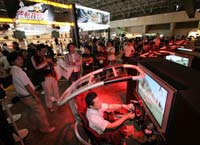|
|
|||||||
|
|
|||||||
|
|||||||
| | Web Japan >> | Trends in Japan >> | Arts & Entertainment >> | Gamers Glimpse the Future | |
|
GAMERS GLIMPSE THE FUTURE Next-Generation Consoles Debut at Tokyo Game Show (October 26, 2006) The tenth annual Tokyo Game Show was held at Makuhari Messe in Chiba Prefecture on September 22 to 24. A total of 148 companies and groups from around the world exhibited at the event. The biggest focus of attention was the PlayStation 3, the next-generation game console due to be rolled out in November by Sony Computer Entertainment. As this was the first public demonstration of the PS3 in Japan, fans were anxious to see the new machine. Next-Generation Consoles Fight for Position While the PS3 was expected to be significantly more expensive than its rivals, Sony announced at the show that the price would be cut from ¥62,790 ($523 at ¥120 to the dollar) to ¥49,980 ($417), surprising the industry insiders present and delighting game fans. Of the PS3's rivals, Nintendo's Wii is expected to hit store shelves in December, while in November Microsoft plans to release a cheaper version of its Xbox 360, which went on sale in 2005. Competition among the three ahead of the Christmas shopping season is expected to be fierce. Exhibitions of these next-generation consoles were packed with fans. Along with the new machines, there were numerous exhibits of the software that gamers will play on them, which were notable for looking crisp and detailed even on a big-screen TV. Demographic Diversity Also noteworthy is the development of new types of games designed to be played on cell phones. While many models have in the past featured rather simple games, there are now games that make use of the increasing computing power of mobile handsets to facilitate online play. Makers of cell phones have no intention of playing second fiddle to handheld game consoles. With the appearance of the next-generation consoles, new types of software, online games, and games made for cell phones, this year's Game Show left visitors with the distinct impression that the gaming audience is growing in both scale and diversity. While the prevailing view in recent years was that the game industry had peaked, the arrival of new users and platforms indicates that it has instead entered a new stage of development. Copyright (c) 2006 Web Japan. Edited by Japan Echo Inc. based on domestic Japanese news sources. Articles presented here are offered for reference purposes and do not necessarily represent the policy or views of the Japanese Government. |
MOVIES IN YOUR POCKET (December 27, 2005) KOJIMA HIDEO (March 9, 2005) |
|
|




